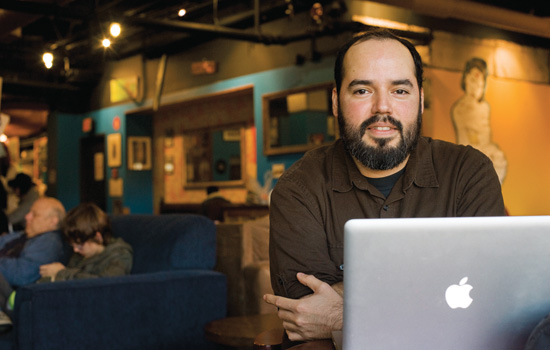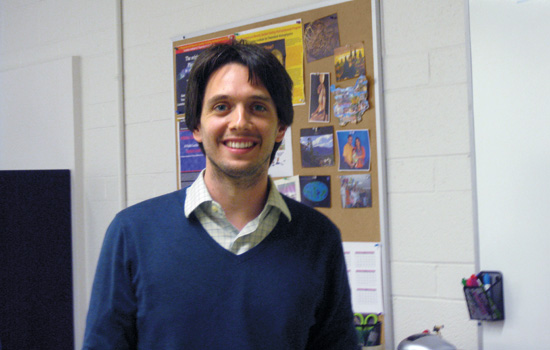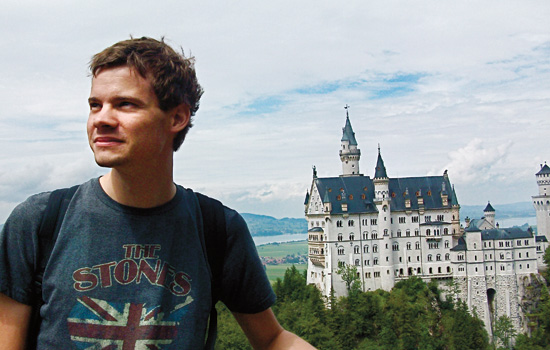First grads get feet wet as scientists
Grant Tremblay ’11 is a post-doctroal fellow in Munich, Germany.
Fabio Antonini, Rodolfo Montez Jr. and Grant Tremblay—the inaugural graduates of the Astrophysical Sciences and Technology doctoral program—think in terms of light years.
It’s a natural habit: They’ve spent years studying astronomical theory or observable phenomena with sophisticated space telescopes like NASA’s Chandra X-ray Observatory, the Hubble Space Telescope and the European Space Agency’s Herschel Space Observatory.
Their hard-won doctoral degrees give them the credentials they need to unlock the next door on their path to a career in science—the post-doctoral fellowship. RIT’s Astrophysical Sciences and Technology doctoral degree program is supported by the Department of Physics, the Chester F. Carlson Center for Imaging Science and the School of Mathematical Sciences.
Everyone involved is watching the first graduates from the program enter the real world of science with all of its possibilities and pitfalls.
Antonini completed a pre-doctoral fellowship at Harvard-Smithsonian Center for Astrophysics last summer while completing his dissertation. There he studied the fate of pairs of stars, or binaries, existing near super massive black holes. He is now a post-doctoral fellow at the Canadian Institute for Theoretical Astrophysics at the University of Toronto.
While at RIT, Antonini studied the dynamics of stars and compact objects near the center of the Milky Way Galaxy. He is a theoretician who discovered a new process that forces a stellar black hole—a compact object typically 10 times more massive than the sun and formed during the collapse of a massive star—into an even more imposing black hole found at the center of galaxies.
Montez’s postdoctoral fellowship with his RIT thesis adviser, Joel Kastner, professor in the Center for Imaging Science, is supported by funding he helped win last year from the Chandra X-ray Observatory. Chandra awarded the team nearly a week of observing time—unusual by any standards—for 21 planetary nebulae, or dying stars.
Montez is leading the RIT team of graduate and undergraduate students and coordinating the research of 24 collaborators around the globe. He represented the team in Spain at the International Astronomical Union Symposium “Planetary Nebulae: An Eye to the Future” in July for an update on the large observing project.
Tremblay is now a post-doctoral fellow with the European Southern Observatory, an assignment he began in August. The astronomical organization—comprised of members of the European Union and Brazil—operates large ground-based observatories in the desert of Chile. The three-year fellowship places Tremblay at “the crossroads for astronomy in Europe” and in contact with leading scientists in his field.
As a fellow at European Southern Observatory, Tremblay is expanding upon his thesis research on Active Galactic Nuclei, or bright galaxies that emit enormous amounts of radiation. Jets of plasma spew copious amounts of energy from a centrally located black hole and illuminate the galaxies from within. In addition to his own research, Tremblay will provide support for the organization’s Very Large Telescope and the future Atacama Large Millimeter/submillimeter Array.
 Rodolfo Montez Jr. ’10 stayed at RIT for his first post-doctoral assignment.
Rodolfo Montez Jr. ’10 stayed at RIT for his first post-doctoral assignment.
 Fabio Antonini ’11 is doing his post-doctoral fellowship in Toronto.
Fabio Antonini ’11 is doing his post-doctoral fellowship in Toronto.










